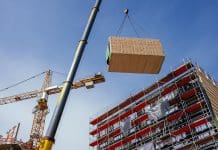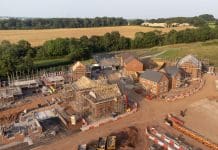Glenigan’s latest construction index for November 2023 shows the UK construction sector is in universal decline, with the overall value of work commencing on site falling by a quarter
The UK construction sector is in a downward spiral, according to Glenigan’s latest index.
Covering the three months to the end of October 2023, performance across every vertical was so poor that there were no improvements against the previous three months or the preceding year’s figures.
The overall value of work commencing on site fell by a quarter on the last three months and 35% lower than 2022.
Glenigan has attributed the UK construction sector’s deflation to the blend of political unsurety both abroad and at home, as well as the government U-turn on HS2 all building to decrease investor and consumer confidence.
Both residential and non-residential works fell sharply
Residential starts fell by 30% on 2022 levels, and 23% on the preceding three months. Within this subsector, private housing decreased by over a fifth(22%) on the last three months and a quarter on the previous year. Social housing fell by a whopping 46% against last year, and 30% on the last few months.
In non-residential projects, hotel and leisure experienced the sharpest fall of 68% on last year and 57% on the last three months. Industrial starts fell by over half compared to last year and health developments fell by 43% on the preceding three months alone.
Office projects, retail, education and community & amenity project starts all experienced minor dips in the last three months, but all fell by over a quarter in comparison to 2022 figures.
Civils finished 36% down on a year ago, with work starting on site falling back by almost a fifth (-18%) compared to the preceding three months. Infrastructure decreased 15% against the preceding three months and remained 38% down on 2022 levels. Utilities starts declined by 32% against 2022 levels and 22% on the previous three months.
The regional breakdown of UK construction is equally gloomy
The North East and East of England experienced a weak period, decreasing by 31% and 34% respectively, remaining 21% and 31% down on last year. Yorkshire and the Humber, and the North West also suffered falls in project starts against both the preceding three months and 2022 levels.
The West Midlands experienced a particularly poor period, with the value of project starts decreasing 27% against the preceding three months, falling 43% compared the previous year.
The East Midlands saw project start performance crash (-44%) when considered against 2022 levels and slashed by a fifth (-22%) compared to the preceding three months.
Decline in the South West was less severe (-7%) compared with the previous three months but fell by almost a third (-29%) compared to last year.
The value of project starts in the South East dropped by a quarter (-25%) when measured against the preceding three months and the previous year.
London fell by 36% on last year’s levels, 19% lower than in the previous three months.
Northern Ireland and Wales project starts also weakened, slipping by 45% and 21%, respectively, against the preceding three months, and down 52% and 23% compared to a year ago. Scotland stumbled -2% compared with the previous three-month period, dropping 38% compared to the previous year.
Previous signs of growth in UK construction have been stunted
Commenting on the lacklustre results, Allan Wilen, Glenigan’s economic director, says, “The November Index will make for disappointing reading as previous editions hinted that green shoots of recovery were starting to poke through. Frustratingly, high interest rates and a weak economy continue to depress the market, reducing the appetite to commence projects until markets stabilise.”
The cancellation of Manchester’s HS2 connection has set public sector progress back
“Government departments are also struggling to prioritise capital projects, despite last year’s capital underspends being rolled forward to the current financial year. Many contractors and developers have been left high and dry by the recent decision to can HS2 Phase 2.
“Whilst funds have been allocated to a Northern development programme, the sector is still to see what this will look like and faces the prospect of having to retender for the business all over again. However, the sector has faced tough times before, and we’re confident current headwinds will die down over the next few years.”














